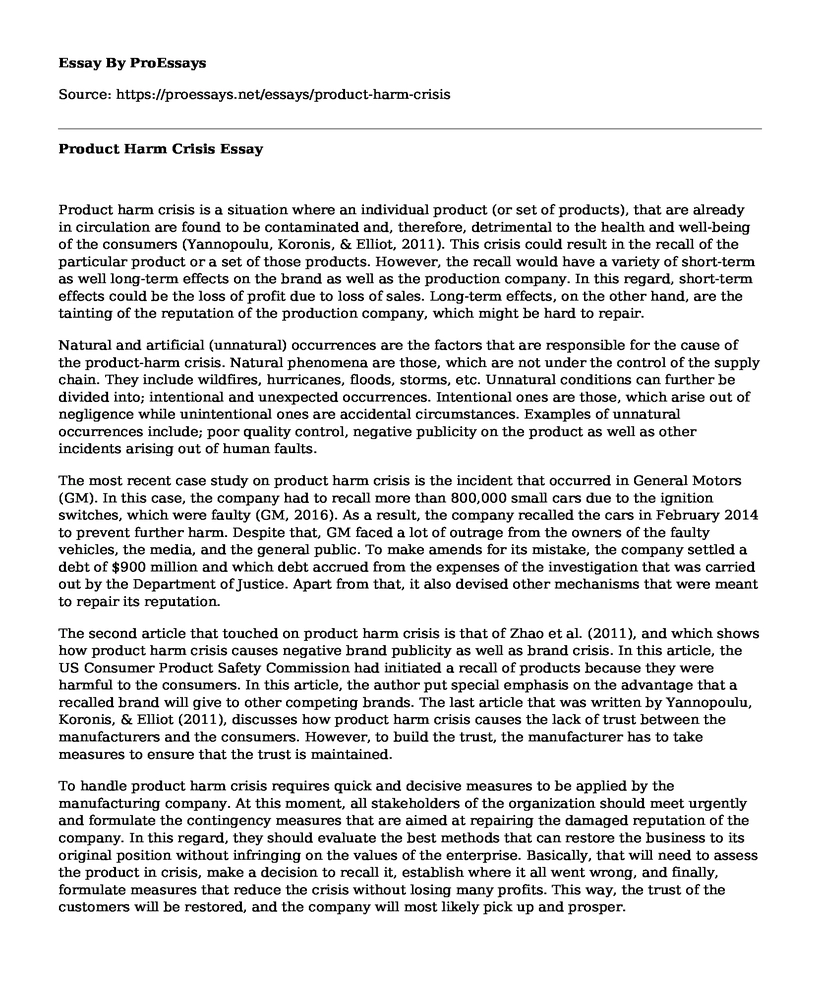Product harm crisis is a situation where an individual product (or set of products), that are already in circulation are found to be contaminated and, therefore, detrimental to the health and well-being of the consumers (Yannopoulu, Koronis, & Elliot, 2011). This crisis could result in the recall of the particular product or a set of those products. However, the recall would have a variety of short-term as well long-term effects on the brand as well as the production company. In this regard, short-term effects could be the loss of profit due to loss of sales. Long-term effects, on the other hand, are the tainting of the reputation of the production company, which might be hard to repair.
Natural and artificial (unnatural) occurrences are the factors that are responsible for the cause of the product-harm crisis. Natural phenomena are those, which are not under the control of the supply chain. They include wildfires, hurricanes, floods, storms, etc. Unnatural conditions can further be divided into; intentional and unexpected occurrences. Intentional ones are those, which arise out of negligence while unintentional ones are accidental circumstances. Examples of unnatural occurrences include; poor quality control, negative publicity on the product as well as other incidents arising out of human faults.
The most recent case study on product harm crisis is the incident that occurred in General Motors (GM). In this case, the company had to recall more than 800,000 small cars due to the ignition switches, which were faulty (GM, 2016). As a result, the company recalled the cars in February 2014 to prevent further harm. Despite that, GM faced a lot of outrage from the owners of the faulty vehicles, the media, and the general public. To make amends for its mistake, the company settled a debt of $900 million and which debt accrued from the expenses of the investigation that was carried out by the Department of Justice. Apart from that, it also devised other mechanisms that were meant to repair its reputation.
The second article that touched on product harm crisis is that of Zhao et al. (2011), and which shows how product harm crisis causes negative brand publicity as well as brand crisis. In this article, the US Consumer Product Safety Commission had initiated a recall of products because they were harmful to the consumers. In this article, the author put special emphasis on the advantage that a recalled brand will give to other competing brands. The last article that was written by Yannopoulu, Koronis, & Elliot (2011), discusses how product harm crisis causes the lack of trust between the manufacturers and the consumers. However, to build the trust, the manufacturer has to take measures to ensure that the trust is maintained.
To handle product harm crisis requires quick and decisive measures to be applied by the manufacturing company. At this moment, all stakeholders of the organization should meet urgently and formulate the contingency measures that are aimed at repairing the damaged reputation of the company. In this regard, they should evaluate the best methods that can restore the business to its original position without infringing on the values of the enterprise. Basically, that will need to assess the product in crisis, make a decision to recall it, establish where it all went wrong, and finally, formulate measures that reduce the crisis without losing many profits. This way, the trust of the customers will be restored, and the company will most likely pick up and prosper.
References
GM. (2015). About GM: Our Company. Retrieved May 24, 2016, from GM: http://www.gm.com/company/aboutGM/our_company.htmlYannopoulu, N., Koronis, E., & Elliot, R. (2011). Media amplification of a brand crisis and its effects on brand trust. Journal of Marketing Management, 27(5/6), 539546.
Zhao. Y., Zhao, Y., & Helsen , K. (2011). Consumer learning in a turbulent market environment: Modeling consumer choice dynamics after a product-harm crisis. Journal of Marketing Research, 48(2), 255267.
Cite this page
Product Harm Crisis. (2021, Mar 04). Retrieved from https://proessays.net/essays/product-harm-crisis
If you are the original author of this essay and no longer wish to have it published on the ProEssays website, please click below to request its removal:
- Leadership and Cultural Competence of Healthcare Professionals
- Paper Example on Exxon Valdez Oil Spill
- Coffee Wars in India Essay Example
- A Budgeting Crisis at Little State University: Case Study
- Cultural Competent for Health Care Providers Paper Example
- Essay Example on Securing Assets: Exploring Security Challenges and Solutions
- Leadership Models - Research Paper Example







